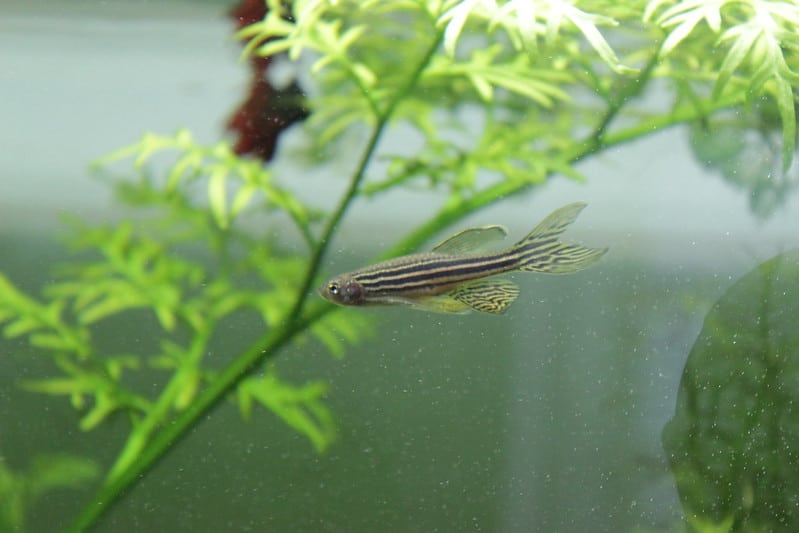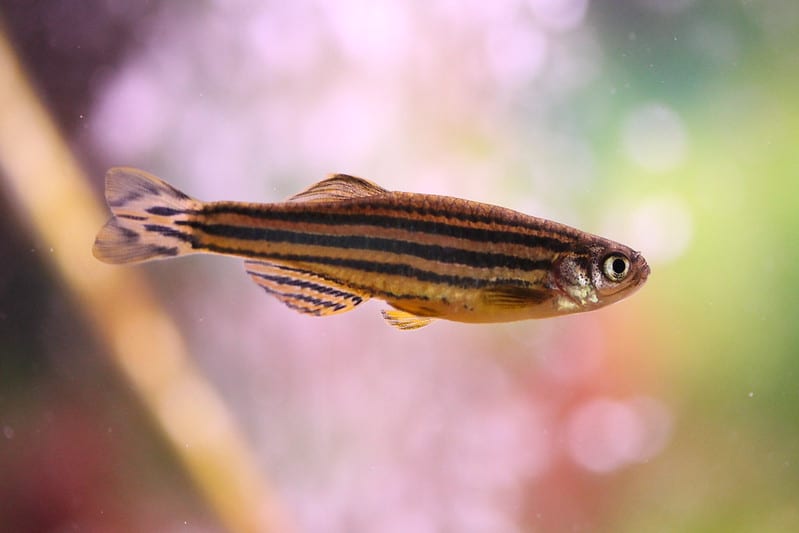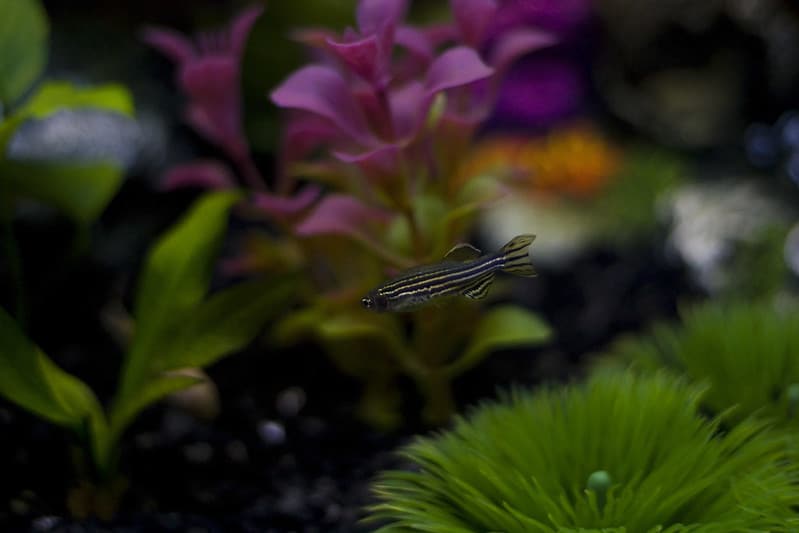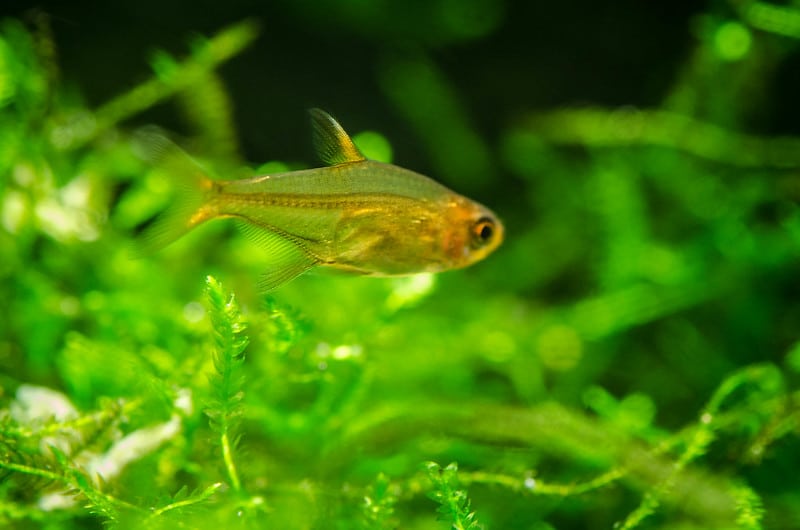Zebra Danio, sometimes called the Striped Danio or Zebrafish, is a popular freshwater fish among aquarium hobbyists. This small species is often selectively bred to achieve different appearances.
In general, they are adaptable and social fish that are perfect for beginners. With various colors and as a shoaling species, they will be a great addition to a community tank. Are you looking to keep some Zebra Danios?
Well, here is the ultimate Zebra Danio care guide that might prove helpful. We will look at every aspect like typical behavior, tank conditions, feeding requirements, and even breeding. Let’s dive in!
| Category | Rating |
| Scientific Name: | Danio rerio |
| Common Names: | Zebra danio, zebrafish, stripped danio |
| Care Level: | Easy |
| Temperament: | Calm and peaceful |
| Size: | Up to 2 inches |
| Colors and marking: | Horizontal stripes of blue, purple, golden, and albino |
| Life Expectancy: | Up to 5.5 years |
| Diet: | Omnivore |
| Family: | Cyprinidae |
| Minimum Tank Size: | 10 Gallons |
| Tank Setup: | Planted tank |
Table of Contents
Overview

Like many other freshwater species, the Zebra Danio is part of the Cyprinidae family. Its scientific name is Danio rerio, and they come from a wide geographical scope, mainly around India and Nepal.
A lot of aquarists like this fish as they are peaceful and social, not to mention extremely hardy and easy to care for. Most stores would sell them for around $2, which is very reasonable for a species that can live up to five years and a half.
In addition, Zebra Danios are highly researched for a variety of reasons as they are often used as test subjects. This is usually for being a vertebrate animal. One fun fact about these fish is that they share 70% of their genes with humans!
Typical Behaviour
One of the most evident behaviours of this species is their social tendencies, which explains why they enjoy shoaling. Shoals may contain hierarchical dominance with non-aggressive behaviours, so there is no need to worry.
While Zebra Danio is generally peaceful, you can occasionally see them biting at long-finned fishes that move more slowly. With this social behaviour in mind, note that these fishes will have a hard time thriving on their own.
Without a lively community around them, they may be less active, become reclusive, and sick. However, shoals that are too large may significantly affect how they behave, even to the point of hyperactivity.
Zebra Danio Appearance

What do Zebra Danios look like? They are naturally small and measure only to 2 inches, with a silver or gold colouration and blue stripes extending from their head to fins. Males tend to take on a more golden hue and are slimmer, while females will appear silvery-white and rounder.
You might also want to look out for the Longfin Zebra Danio, which is a slightly different variation. This species is bred to display longer fins.
In terms of colouration, there really is no limit in this industry, especially the one that are genetically modified. The natural Albino Zebra Danios are rare in the wild but common among aquarium owners.
Meanwhile, some have bred out the blue stripes in these fishes to leave only the golden body and silvery stripes. You will also find those that glow in the dark with a range of fluorescent colours. These are called the Glo Morphs. Of course, they will not be able to survive in the wild as they would be preyed on.
General Size
Adult Zebra Danios are usually around 2 inches long, although they may grow even bigger in ponds. They have more space to swim around and more natural foods than in an indoor aquarium. As a result, the fish will thrive and grow larger.
Habitat and Tank Conditions
In terms of natural habitat, they come from a range of tropical and subtropical areas. This includes India, Bhutan, and Bangladesh. They are used to temperatures of around 77-82°F in the summer and colder in the winter.
Habitats vary from idle rivers to flooded ponds and rice paddies. There are usually silt on the bottom, rocky substrates and overhanging branches over the streams. The changing light levels will also change as winter interchanges with summer.

Tank Requirements for Zebra Danio
Due to these varying conditions that Zebra Danios are used to, they become tough and adaptable. It is quite easy to replicate their habitat in a home aquarium.
We recommend using a substrate of soft sediment and sands, which should be washed first. Make sure the water is between 64 and 77°F with a pH of 6.0 to 8.0. You could add plants like Java Fern to increase the oxygen content and number of available hiding spots.
Not only that, freshwater plants are a great way to produce a natural and calming environment for the fish. It will even discourage aggressive behaviours! In trying to replicate the natural homes of this species, maybe add bogwood pieces and round pebbles.
Furthermore, we recommend installing a good filtration system that can keep the tank water clean and healthy. They like moderate lighting, which you can provide artificially for around 12 hours each day. Do not hesitate to adjust this according to the other community fish you have.
Aquarium Size
How large should the tank be to keep Zebra Danios? At the very least, it should be 10 gallons. The best thing is to keep 1 of them per 2 gallons, which means 10 gallons can make a good home for 5 of these little fishes. This provides enough space for them to swim around freely and shoal without overpopulating the tank.
Zebra Danio Care
As long as you ensure a high standard of cleanliness and maintenance, your Zebra Danio will be easy to care for. One of their common diseases caused by water bacteria is mycobacteriosis.
An infected fish may show several signs or symptoms, including ulceration and skin inflammation, lethargy, and fin loss. To avoid outbreaks, keep the water quality good and try to let your fish live as stress-free as possible.
In treating this disease, we generally do not recommend antimicrobial measures. Instead, remove the infected fish from the tank and change the water first to avoid spread.
You may want to know that mycobacteriosis can infect humans, so make sure that you have no open wounds! You can also wear thick aquarium gloves for extra precautions.
Zebra Danios are also susceptible to intestinal nematodes, which is caused by some nematode worm species. This will cause the fish to be lethargic, lose weight, and appear darker. Likewise, it is best to remove the infected fish and disinfect the tank.
Diet and Feeding
As natural omnivores, the wild compatriots usually eat anything from worms and algae to mosquito larvae and crustaceans. In a tank, you can feed them plenty of food types. This includes algae flakes.
We also recommend mixing it up sometimes with fresh vegetables. You can toss in some Zucchini or Cucumber, with the occasional treats of Daphnia and bloodworms. While live foods are always a good option for your tank, Zebra Danios can thrive well on dried and frozen alternatives.
When there is fry in the tank, you should only feed them special foods, followed by baby fish foods. Spread feeding times to several times per day and provide only enough food they can finish in 3 minutes.
Tank Mates

The best thing about Zebra Danios is how easy it is to find perfect fit tankmates for them, especially because they are naturally used to co-existing with a lot of species. From Indian Flying Barb, Ember Tetra to Emerald Pufferfish. There are also Bengal Turquoise Danio, Celestial Pearl Danio and Rosy Barbs.
Other than fellow fishes, you may consider housing them with other species. This could be snails such as Nerites, frogs such as African Dwarf Frogs, or even shrimps like Blue Velvet Shrimp.
However, be careful and avoid adding long-finned fish species with your Zebra Danios as they tend to chase them around and nip their fins. This includes Sailfin Molly and Elephant Ear Guppies; both are not the best tankmates for them.
Do not keep them with predatory fishes too, which includes a lot of catfish species like the Redtail Catfish. They may prey on your Zebra Danio and you would not want that to happen!
Keeping Multiple Zebra Danios in the Same Tank
Unlike some solitary species who do well on their own, Zebra Danios would not thrive without at least 5 of their own kind! Being alone will stress them out and make the more aggressive. They are engineered to survive in shoals, so it is best to let them be social. Especially if you want your fishes to live healthily and happily in the aquarium.
Zebra Danio Breeding
Here’s some good news for beginning aquarists: you can easily breed Zebra Danio at home! All you need is a breeding tank of at least 5 gallons, filled with water of 71 to 80°F.
Firstly, make sure that you have separated the male and female for a couple of weeks, feeding them good quality live foods. The females should grow fuller as they develop the eggs. Move them into the breeding tank, placing 2 males for each female.
The fish will usually spawn in 24 hours, and you can spot translucent eggs. On the other hand, white eggs mean they are infertile. Remember to immediately remove the adult fishes as soon as possible, or they will eat the eggs.
Finally, it will take roughly 3 days for these eggs to hatch and the tiny fry will then come out with their transparent bodies. Congratulations! You have successfully bred your Zebra Danios and get ready to introduce juvenile fishes into your tank.
Should you Get Zebra Danios for Your Aquarium?
All in all, Zebra Danios are truly a magnificent species that can liven up your tank ecosystem. It is an excellent starting point for many freshwater aquarium owners, thanks to their peaceful and social nature.
Whether you are a beginner or experienced aquarist, you may want to consider getting a few Zebra Danios. Their vibrant colours and active shoaling behaviours will keep your aquarium interesting and full of character.
Not only that, these fishes are naturally hardy and wired to survive in a range of water conditions. This means they are ideal to introduce to a community tank and extremely easy to take care of. Of course, it is always a good idea to keep the water quality high and allow your fishes to live happily.
So, should you get Zebra Danios for your aquarium? If you ask us, the answer is most probably a resounding yes!






